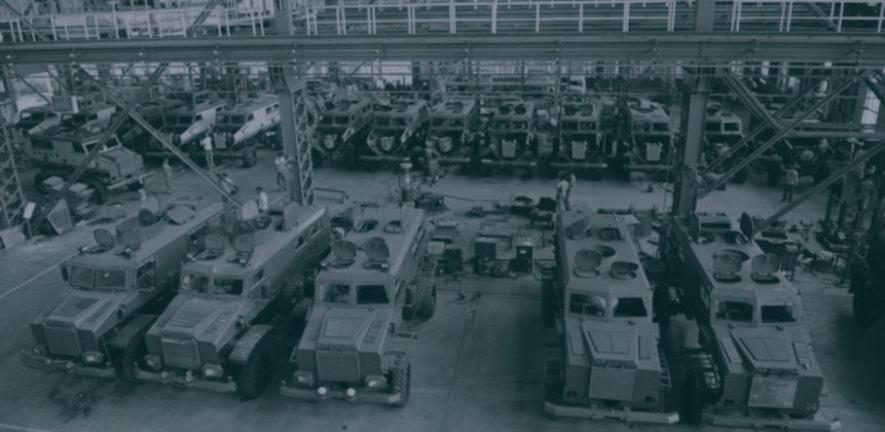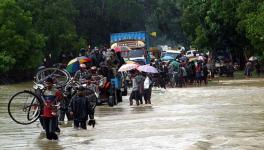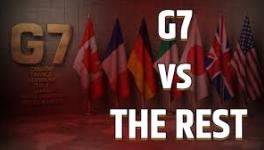India Arms Exports: A Protection of Civilians Lens is Required

Representational Image.
A grainy picture of an ostensibly ‘Made in India’ part of a bomb in Gaza created a social media maelstrom last month and highlighted a growing concern about India’s arms exports exacerbating the suffering of Palestinian civilians in Gaza.
Although it has not had much direct impact on India’s national security, the Israel–Palestine conflict has been an important foreign policy issue for India, both in terms of its traditional stand on the Palestinian struggle and its changing geo-political relations in the region.
The recent attention to India’s role in the conflict has also helped bring into the spotlight the less-than-transparent global arms trade and its evolving regulatory regime, in light of the disproportionate cost borne by civilians in many contemporary conflicts.
This is not the first time India’s nascent yet growing arms export industry has been linked with harm to civilians. In the ongoing civil war in Myanmar, the United Nations (UN) special rapporteur on human rights in the country, Tom Andrews, noted in 2023 that India’s post-putsch arms exports to the country amounted to at least US $51 million at the time (including sonar parts for naval vehicles and electronic detonators).
His office has released data noting that arms exported by India and others may have been lethally used against unarmed civilians, resulting in “probable war crimes” and that some of these exports “likely violate” India’s obligations under the Wassenaar Agreement.
This is not the first time India’s nascent yet growing arms export industry has been linked with harm to civilians.
The agreement is a non-binding multilateral export framework among various arms exporting countries to regulate themselves, including by ending arms transfers to end users whose behaviour could become a “cause for serious concern”.
As a result of these reports from the UN special rapporteur, Singapore, another arms exporter to Myanmar, decreased its exports of arms reportedly by 83 percent. Other countries have independently imposed arms embargoes on this civil war-impacted nation. In India, there has been no discernible policy change to date in light of these reports.
India has also exported arms to Armenia. In 2022, the country received Akash surface-to-air missiles while the country was involved in a conflict with Azerbaijan. Armenia has continued to receive arms from India, and this month a statement was issued by the Lemkin Institute for Genocide Prevention, noting its alarm at the “weapons and tactical exchanges” between the United States, Israel, India and Europe and the South Caucasus, contributing to building authoritarian police forces in the region. To date, there appears to be no change in India’s engagement in the region.
In the last few decades, India has emerged as one of the top importers of arms globally. It has also established a nascent arms export industry, which has been further propelled by the atmanirbharta (self-reliant) vision of the Modi government.
With the protection of civilian concerns in Israel–Gaza, Myanmar and Armenia coming to the fore, it is important to recognise that arms transfer can have legal, moral and reputational risks for exporting countries. One significant way to minimise these risks is by applying a protection of civilians lens to all arms exports.
While these allegations are specific to India, such scrutiny has increasingly become the norm for traditional arms exporters and course correction is being demanded after unnecessary and disproportionate civilian harm, including via judicial means.
India as a relative newcomer on the block is well-placed to front-end its management of civilian harm within its nascent arms export industry through the adoption of a protection of civilians lens.
It is a natural progression for a democratic country that values human rights as enshrined in its Constitution and is keen to demonstrate its responsible global power status within a rules-based international system.
A protection of civilians lens
So what is a ‘protection of civilians lens’? It is a term with slightly differing parameters among different UN member States, multilateral and non-governmental organisations and others, to convey a recognition of civilian harm to individuals and communities in conflict and the need to protect them from this harm.
The organisation PAX has defined civilian harm as “all negative effects on civilian personal or community well-being caused by use of force in hostilities. Effects can occur directly (death, physical or mental trauma or property damage) or indirectly through the destruction of critical infrastructure, disruption of access to basic needs and services or the loss of livelihood”.
As a result of these reports from the UN special rapporteur, Singapore, another arms exporter to Myanmar, decreased its exports of arms reportedly by 83 percent.
Civilians are those not members of armed forces or organised armed groups and hence not participants in violence. A protection of civilian lens is an appraisal and subsequent application of specific measures to avert civilian harm.
The appraisal involves applying standards of international humanitarian law and human rights law, notions of morality, military honour and acknowledgment of our humanity to situations of conflict in order to assess the harm occurring.
There are a number of specific measures that have been applied in various conflict situations by military and non-military actors in furtherance of protecting civilians from the harm of conflict.
These include a range of military and non-military actions such as support to UN peace-keeping missions mandated with protecting civilians, supporting peace negotiations, disarming child soldiers, responding to sexual violence, negotiating access for food delivery, evacuating civilians from entrapment in conflict zones, supporting first responder groups, combating disinformation which causes initial or further violence and— most relevant for the purposes of this article— scrutinising weapons sales that may cause disproportionate harm to civilians or curtailing use of certain types of weapons.
A protection of civilians lens application in arms exports should be viewed as a proactive method to avoid harm before it occurs, as well as a method to respond to harm occurring and a method applied in the aftermath of harm, by curtailing weapons exports.
The advantage of a protection of civilian lens is that it centres the focus on the harm to civilians and places their needs at the centre of a conflict, rather than focusing on the broader politics of the situation and other dynamics.
So, for example, the conversations in India on the latest Israel-Palestine conflict vis-à-vis alleged exports of weapons to Israel centres on two views, some view it as support to Israel in their time as they have done for India in its last war, or as India violating the traditional foreign policy stand India has had vis-à-vis the Palestinian struggle.
However, a protection of civilian lens skirts these discussions to examine harm endured by civilians on all sides (both Israel and Gaza) and compels one to act to minimise harm to fellow human beings who are not participating in the fighting irrespective of one’s political contentions.
Such a protection of civilian lens appraisal and response would also minimise reputational harm (and potential legal jeopardy) for India as a growing responsible power, which would occur by killing innocents and we would be protecting their rights in line with our democratic traditions— a reputational and moral win.
In the last few decades, India has emerged as one of the top importers of arms globally.
The impact of uncontrolled arms supply in conflict on civilians is wide-ranging. In addition to fueling and sustaining conflict, it contributes to large-scale deaths and injuries of civilians and damage to infrastructure such as hospitals, schools, water and power systems— all vital for civilian survival.
It also causes damage to roads. The presence of unexploded ordinances can exacerbate starvation, as food for those trapped in bombed-out areas creates an enormous supply challenge. It leads to the forced displacement of people from their homes and lives, tearing communities apart sometimes for a generation, even when the guns fall silent.
Unexploded ordinances also pose a continued hazard to people and their communities, for example, contaminating land for food or water for years. This is not an exhaustive list.
Applying a protection of civilians lens to Indian arms exports
There are various ways to apply a protection of civilians lens to exports of arms by India, including via governmental legislation and regulations, political and judicial oversight, civil society engagement (including think tanks), media reporting and individual private companies manufacturing arms undertaking a commitment to uphold human rights and humanitarian law as part of their corporate responsibility.
India has signed some significant international law instruments. Obligations under these could enable adherence to a protection of civilians lens. These are the Universal Declaration of Human Rights, the Geneva Conventions 1949, the Convention on Certain Conventional Weapons 1984, the Missile Technology Control Regime and the Wassenaar Arrangement 1996.
The last is primarily a cold war-influenced non-binding self-regulatory mechanism of select countries (42 signatories). The subsequent Global Arms Trade Treaty, 2014, is a legally binding instrument sharing similar regulatory aims to the Wassenaar Arrangement.
India as a relative newcomer on the block is well-placed to front-end its management of civilian harm within its nascent arms export industry.
In addition, the Arms Trade Treaty centres on civilian harm, reflective of the emergence and growth of civilian protection as a concept since 1999, when the first UN Security Council Resolution on this topic was tabled.
India has also signed the Genocide Convention of 1948, invocation of which has occurred vis-a-vis the situation in Gaza.
Today, the Global Arms Trade Treaty is the principal instrument to regulate arms trade and minimise harm to civilians. India remains an outlier among democratic arms-exporting countries to have not signed this arms trade treaty.
Signatories include the United States, France and Israel, all significant exporters to India. Russia, another significant exporter to India, is also not a signatory but India’s neighbour China is, and the latter is a significant arms exporter to other countries in South Asia. The arms trade treaty has 112 signatories to date.
Apart from arms regulation, there are numerous instruments banning certain weapons use because of their disproportionate harm to civilians. There is a new non-binding instrument added to this regime in 2022, the Political Declaration on Strengthening the Protection of Civilians from the Humanitarian Consequences arising from the Use of Explosive Weapons in Populated Areas.
India again is an outlier among democratic arms exporters in not being a signatory to this instrument. Primary democratic exporters of arms to India, the United States and France are signatories. Israel is not. Today, 87 states have signed this declaration since its adoption in November 2022, including leading global South countries such as Brazil and Indonesia. A record number of signatories in such a short space of time for an international instrument.
This declaration addresses an issue that has been a cause of significant civilian deaths and injuries, and in 2023 alone, explosive weapons contributed to 63 percent of civilian deaths in conflict zones.
The presence of unexploded ordinances can exacerbate starvation, as food for those trapped in bombed-out areas creates an enormous supply challenge.
It commits State signatories to minimise the use of explosive weapons, which are conventional weapons such as bombs, grenades, missiles and land mines in populated areas.
Becoming a signatory of this declaration is an easy win for India and would affirm its position as a responsible arms-exporting State, which upholds the international rules-based order. This would fit well with India’s ambitions to be a global power player and be reflective of its democratic values.
Apart from signing international instruments, India could also strengthen its legislative and regulatory regime to ensure a protection of civilians lens is applied to potential arms sales (both defence and dual-use items—military/industrial). For example, by incorporating clauses into licensing requirements in arms export agreements for end-use monitoring for human rights and humanitarian law violations.
India could also pass legislation similar to the United States “Leahy Law” which restricts defence articles and services to parties implicated in gross human rights abuses, or draw inspiration from the more comprehensive European Union Common Position on Arms Exports 2008, where the exporting States agree to halt exports if they ascertain a risk that their weapons may potentially be used to cause harm or their weapons can potentially cause or fuel further conflict.
In addition, India could also pass legislation mandating the application of a protection of civilian lens in the public and private defence industry, for example, by stipulating adherence to standards such as the United Nations Guiding Principles on human rights and business, as part of companies corporate responsibility, be it defence and dual purposes equipment exported under Union ministry of commerce and ministry of defence.
Some demarches on the Israel–Palestine conflict have been raised by Opposition Indian politicians, but there could be a deeper understanding of this protection of civilian lens.
At the parliamentary level, there could be more scrutiny on the protection of civilians’ concerns through committees such as defence, external affairs and commerce.
This is par for the course in countries such as the United Kingdom, which has had a Committee on Arms Exports Control. Furthermore, the Parliament as a whole could also vote on such defence sales as occurred in the Canadian Parliament, or individual politicians and parties could take a position on the protection of civilians consequences as done in Spain.
Some demarches on the Israel–Palestine conflict have been raised by Opposition Indian politicians, but there could be a deeper understanding of this protection of civilian lens and consistent application in the future to various situations.
In the private sector, Indian arms manufacturers should be cognisant of increasing global scrutiny in recent years of the role of companies in harming civilians in conflict zones.
Companies can no longer leave this responsibility solely to State authorities to regulate. Indian companies can contribute to a protection of civilian lens by adopting internal procedures as part of their corporate social responsibility, like committing to the UN guiding principles and ensuring human rights due diligence.
Defence manufacturing is often intertwined with State policy in most countries, so this could pose a reputational threat for India, in addition to being a legal and reputational issue for a company with corporate complicity in potentially adding and abetting war crimes, etc.
It is a series of fine lines between doing business and being complicit in international humanitarian law and human rights violations. An example of such corporate responsibility was recently demonstrated by a Japanese company that suspended arms export agreements in light of the International Court of Justice ruling on the Israel–Palestine case.
Civil society, including think tanks, plays a robust role in ensuring the development of a protection of civilians lens in government policy-making and advocating for concrete action, even when these weapons sales are to a ‘friendly country’.
It is a series of fine lines between doing business and being complicit in international humanitarian law and human rights violations.
A scan of think tanks covering defence and foreign policy sites yielded little on arms sales and potential protection of civilians issues being discussed along similar lines to those in other democratic arms exporting countries for example, Council on Foreign Relations in the US and Chatham House in the UK.
There has been fairly robust civil society engagement in the Israel–Palestine conflict by prominent individuals, organisations and even labour unions. However, a capacity for the protection of civilians lens needs to be developed commensurate with India’s growing profile in wider parts of the world.
The media, primarily newsprint and online, have contributed to spot-lighting the arms sales to Israel, albeit with limited attention to Myanmar and negligible to Armenia or elsewhere where Indian arms companies have exported weapons, such as the Philippines.
The media could equip itself better by applying a protection of civilians lens for a nuanced analysis of arms exports, given the upward trajectory in India’s arms industry and geo-political engagement.
In conclusion, it is worth reiterating that arms sales represent business profits intertwined with security and foreign policy aims, and consideration of protecting civilians from harm is rarely the primary consideration for any arms-exporting democracy.
However, it is never entirely missing from the conversation and this is even more true today. Additionally, the protection of civilians in conflict zones is inevitably spot-lighted at global power high tables such as the UN Security Council, which India aspires to. So, a protection of civilians lens is a worthwhile investment for the Indian polity.
Sarah Khan is a former United Nations International Civil Servant.
Get the latest reports & analysis with people's perspective on Protests, movements & deep analytical videos, discussions of the current affairs in your Telegram app. Subscribe to NewsClick's Telegram channel & get Real-Time updates on stories, as they get published on our website.
























